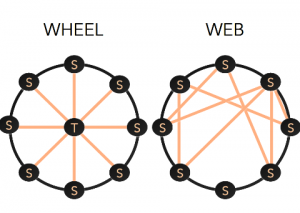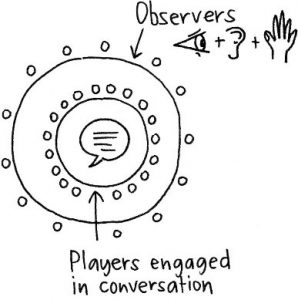
Discussion, Mastered?
FMG TLC event Mastering Discussions
On Monday, April 9th at CREA, the FMG Knowledge Sharing Matchmakers organized an event called “Mastering Discussion”. The goal of the event – as it sounds – was to provide tips on how to harness the power of discussion in the classroom. The event itself was well attended, with a wide range of teaching faculty across the FMG attending. We had junior teachers from Communication Science, senior teachers from Psychology, and everyone in-between all discussing (pun intended) how to use discussion in the classroom. And, to help us figure out this process, we invited a true expert in the field to show us how it’s done – Mariska Knol.
How did we do it?
In planning the event, it seemed natural to make this event a discussion. A discussion about discussion? A bit meta … perhaps. But still, we had to go there. In practice, this meant we literally set the room up like a discussion … gave the awesome Mariska the microphone … and watched the magic unfold.
And, how did it go?
As the organizers, we were truly thrilled to see how quickly all attendees found themselves immersed in the discussion. It took only a few minutes to really see a rich discussion unfold, and in truth, we got the sense that no one wanted to stop when it came time for drinks. What a great feeling! It was very clear to us that discussion is not something we just “know how to lead” and that there is so much to learn. And in truth, even though we were the organizers, we found ourselves taking plenty of notes too!
So, did we make you masters in discussion?
Well, not yet. If nothing else, we certainly learned from Mariska that the art of a good discussion takes time and practice. But, we also learned plenty of tips and tricks to get us started – AND we are hearing that some of you are already trying these tips in the classroom. In fact, one of our attendees told us “I tried the fishbowl technique in my guest lecture, and it was GREAT!” We love hearing feedback like this. Makes our academic hearts so happy.
Speaking of those lessons learned … there were A LOT. Here are the lessons that stuck with us:
- Set the Stage for Your Students. Sometimes students do not get the sense that they are learning during class discussion. Early on, explain to students WHY you opt to use discussion in your classroom and why discussion matters. Setting up a norm of discussion early on can help ensure students feel comfortable. You might even cite some of the benefits that Mariska suggested! (Pro Tip: see page 3 of her slides)
- Know what Discussion Can Do. Discussion is powerful. It can engage students, help them connect with the literature, connect content with their lives, help students identify their opinion, and even help students handle difficult events. #GoodStuff
- Know that Discussion Can Be Difficult. For many of us, discussions are an intimidating process. Polarized or sensitive topics can be difficult to manage. Balancing voices and views can feel like trying to solve a jigsaw puzzle. There is a fear that an active discussion can turn into a chaotic classroom. There can be challenges in reflecting on your role as a teacher. And even identifying the “right” topic can be tough. But, that doesn’t mean that discussion isn’t worthwhile.
- Prevent the Café Chat. As teachers, we want the discussion to be engaging and comfortable – but at the same time, we want it to be thoughtful and enriching. Mariska reminded us that sticking to the “hard stuff’ – not just glossing over the disagreements but really tackling them head on – as well as making the effort to connect discussion to course learning goals really helps ensure we go beyond a café chat.
- Practice Makes Perfect! Mariska demonstrated SO MANY different ways to support an enriching discussion. Some of our favourite tips were:
- Remove physical obstacles(like tables!) if they block you from your students.
- Take a physical step backwhen appropriate to give students room for discussion.
- Rely on your nonverbal gesturesto invite conversation from others.
- Break eye-contact. Simply looking down will invite students to look at each other instead of you.
- Invite students to counterargue each other’s points.
- Imagine a concert. You are the conductor, but your students make the music. This balance where you orchestrate and students do the work certainly takes practice – but remember, practice makes perfect!
- Know the difference between a wheel (conversation goes THROUGH the teacher) and web (conversation is student to student) and decide which is best for your discussion. Think about how your nonverbal behaviour (like looking down / away
- Paraphrase! Paraphrasing is your secret weapon for helping keep a discussion on track. You can give the content your own twist, you can highlight certain points while muting others, you can use it to jump from web to wheel, and you can use it to make individuals feel heard and seen. It’s a great way to expand content and create connection. When in doubt, paraphrase!
- Consider using different techniques to help you get the discussion moving. As our attendees learned, the “fishbowl” technique can be a great way to get a smaller conversation started and provide room for others to contribute when ready. It can be particularly great when some students don’t feel ready to contribute, or when there are extreme positions to be discussed.
- Similarly, we saw that the “on the line” technique can be a great way to get students reflecting on their opinion – it provides them a space to think about their beliefs and then EVERYONE takes a position.
- We even saw that you can go crazy by combining them – use “on the line” to identify opinions, and then select from the line how to build your fishbowl. Fun!
And, of course, let’s not forget the very simple but SUPER effective POPCORN technique. To wrap up a class or discussion, try asking: “Did you hear something new or interesting? Tell me one sentence that POPS!” Who knew popcorn could be so effective – we thought it was just tasty!










